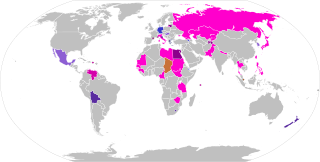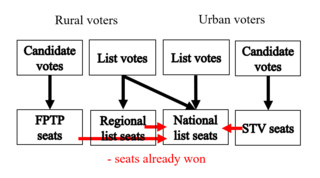
Proportional representation (PR) refers to any type of electoral system under which subgroups of an electorate are reflected proportionately in the elected body. The concept applies mainly to political divisions among voters. The essence of such systems is that all votes cast – or almost all votes cast – contribute to the result and are effectively used to help elect someone. Under other election systems, a bare plurality or a scant majority are all that are used to elect candidates. PR systems provide balanced representation to different factions, reflecting how votes are cast.

The additional-member system (AMS) is a two-vote seat-linkage-based mixed electoral system used in the United Kingdom in which most representatives are elected in single-member districts (SMDs), and a fixed number of other "additional members" are elected from a closed list to make the seat distribution in the chamber more proportional to the votes cast for party lists. It is distinct from using parallel voting for the list seats in that the "additional member" seats are awarded to parties taking into account seats won in SMDs – these are ignored under parallel voting.

Mixed-member proportional representation is a type of representation provided by some mixed electoral systems which combine local winner-take-all elections with a compensatory tier with party lists, in a way that produces proportional representation overall. Like proportional representation, MMP is not a single system, but a principle and goal of several similar systems. Some systems designed to achieve proportionality are still called mixed-member proportional, even if they generally fall short of full proportionality. In this case, they provide semi-proportional representation.

Overhang seats are constituency seats won in an election under the traditional mixed-member proportional (MMP) system, when a party's share of the nationwide votes would entitle it to fewer seats than the number of individual constituencies won. The electoral reform in Germany removed the overhang seats, and replaced with Zweitstimmendeckung.

Electoral reform in New Zealand has been a political issue in the past as major changes have been made to both parliamentary and local government electoral systems.

In political science, parallel voting or superposition refers to the use of two or more electoral systems to elect different members of a legislature. More precisely, an electoral system is a superposition if it is a mixture of at least two tiers, which do not interact with each other in any way; one part of a legislature is elected using one method, while another part is elected using a different method, with all voters participating in both. Thus, the final results can be found by calculating the results for each system separately based on the votes alone, then adding them together. A system is called fusion or majority bonus, another independent mixture of two system but without two tiers. Superposition is also not the same as "coexistence", which when different districts in the same election use different systems. Superposition, fusion and coexistence are distinct from dependent mixed electoral systems like compensatory (corrective) and conditional systems.

The Chamber of Deputies is the lower house of the Plurinational Legislative Assembly of Bolivia. The composition and powers of this house are established in the Political Constitution of the State. The session room is located in the Legislative Palace building in Plaza Murillo.

The majority bonus system (MBS), sometimes referred to as the reinforced proportionality electoral system is a semi-proportional method of electing multiple representatives. The majority bonus is typically classified as a mixed electoral system, as it integrates both the proportionality and winner-take-all principles to provide mixed-member majoritarian representation. An academic term for such a hybrid system is fusion, which means an independent combination of two systems in which the two formulas are mixed within the same district (the district in question may be a single, nationwide constituency). This makes it distinct from other mixed systems such as parallel voting (superposition) and coexistence. A majority bonus may also be one of the properties of a supermixed system.
A party-list system is a type of electoral system that formally involves political parties in the electoral process, usually to facilitate multi-winner elections. In party-list systems, parties put forward a list of candidates, the party-list who stand for election on one ticket. Voters can usually vote directly for the party-list, but in other systems voters may vote for directly individuals candidates within or across party lists, besides or instead of voting directly for parties.

Semi-proportional representation characterizes multi-winner electoral systems which allow representation of minorities, but are not intended to reflect the strength of the competing political forces in close proportion to the votes they receive. Semi-proportional voting systems are generally used as a compromise between complex and expensive but more-proportional systems and simple winner-take-all systems. Examples of semi-proportional systems include the single non-transferable vote, limited voting, and parallel voting.

An electoral or voting system is a set of rules used to determine the results of an election. Electoral systems are used in politics to elect governments, while non-political elections may take place in business, non-profit organisations and informal organisations. These rules govern all aspects of the voting process: when elections occur, who is allowed to vote, who can stand as a candidate, how ballots are marked and cast, how the ballots are counted, how votes translate into the election outcome, limits on campaign spending, and other factors that can affect the result. Political electoral systems are defined by constitutions and electoral laws, are typically conducted by election commissions, and can use multiple types of elections for different offices.

A winner-take-all electoral system is one where a voting bloc can win all seats in a legislature or electoral district, denying representation to any political minorities. Such systems are used in many major democracies. Such systems are sometimes called "majoritarian representation", though this term is a misnomer, as most such systems do not always elect majority preferred candidates and do not always produce winners who received majority of votes cast in the district, and they allow parties to take a majority of seats in the chamber with just a minority of the vote.

Scorporo is a partially compensatory, mixed-member majoritarian electoral system, sometimes referred to as a negative vote transfer system (NVT) whereby a portion of members are elected in single-member districts (SMDs) and a portion are elected from a list. It may be fully defined as a parallel voting system which excludes a portion of the SMD winners' votes in electing the proportional tier, to result in a more proportional outcome. The exclusion of a portion of the SMD winners' votes is what makes scorporo fundamentally different from parallel voting and somewhat closer to the additional member system in the UK in theory. However, the design proved particularly susceptible to the decoy list strategy, and as a result by 2001 had devolved into a de facto parallel voting system. The scorporo method is only known to have been used in Italy, but a similar version is in used for the National Assembly of Hungary.

The dual-member mixed proportional (DMP) voting method is a mixed electoral system using a localized list rule to elect two representatives in each district. It is similar to other forms of mixed-member proportional representation but differs in that all representatives are elected locally in small districts, rather than requiring separate list seats to be filled in large regional or nationwide districts. In the first step, one seat in each district is awarded to the candidate with the most votes, as with first-past-the-post voting rules. In the second step, underrepresented parties are assigned secondary seats in the districts in which they won the most votes, which creates an overall proportional result.

A mixed electoral system is one that uses different electoral systems to elect different seats in a legislature. Most often, this involves a winner-take-all component combined with a proportional component. The results of the combination may be mixed-member proportional (MMP), where the overall results of the elections are proportional, or mixed-member majoritarian, in which case the overall results are semi-proportional, retaining disproportionalities from the majoritarian component. Systems that mix more than two components are sometimes called supermixed.

Rural–urban proportional representation (RUP), also called flexible district PR, is a mixed electoral system which combines the use of single- and multi-member constituencies in a lower tier and top-up seats in an upper tier to meet the different needs of both rural and urban areas, while protecting the objective of proportionality. The term was coined by Fair Vote Canada, which devised a rural–urban system with the intention of meeting the special challenges of Canada's geography, which includes wide-flung, sparsely populated areas.

A mixed single vote (MSV) is a type of ballot in mixed-member electoral systems, where voters cast a single vote in an election, which used both for electing a local candidate and as a vote for a party affiliated with that candidate according to the rules of the electoral system. Unlike most mixed proportional and mixed majoritarian systems where voters cast two votes, split-ticket voting is not possible under MSV. This significantly reduces the possibility of manipulating compensatory mixed systems, at the price of reducing voter choice. An alternative based on the mixed single vote that still allows for indicating different preferences on different levels is the mixed ballot, which functions as a preferential (mixed) single vote.

The mixed ballot transferable vote (MBTV) refers to a type of vote linkage-based mixed-member electoral system where a group of members are elected on local (lower) tier, for example in single-member districts (SMDs). Other members are elected on a compensatory national (upper) tier from a list and voters cast a single ballot where they may indicate their preferences separately.

Mixed-member majoritarian representation (MMM) is type of a mixed electoral system combining winner-take-all and proportional methods, where the disproportional results of the winner-take-all part are dominant over the proportional component. Mixed member majoritarian systems are therefore categorized under semi-proportional representation, and are usually contrasted with mixed-member proportional representation (MMP) which aims to provide proportional representation compensation ("top-up") seats.

Compensation or correction is an optional mechanism of electoral systems, which corrects the results of one part of the system based on some criterion to achieve a certain result, usually to make it more proportional. There are in general two forms of compensation: vote linkage and seat linkage.
















